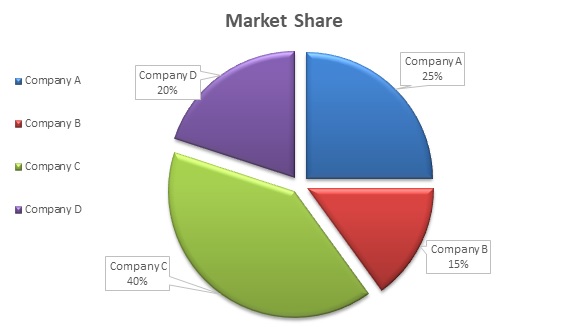- Business Concepts ›
- Marketing and Strategy ›
- Market Share
Market Share - Definition, Importance, Types & Example
This article covers meaning & overview of Market Share from marketing perspective.
Market Share Definition
Market share is the proportional share of total market volume that belongs to the company when compared to the competitors in the same segment or category. Market share is usually in terms of revenue, customers or sales and is mostly expressed in percentage of the entire market accounted for by a company or brand vis-à-vis its competitors. The market share can be defined in terms of dollar share or unit share.
The term revenue market share (RMS) is the percentage the company has acquired as a percentage of total sales for the industry. RMS is also sometimes referred as dollar market share. Customer market share (CMS) is the percentage of customers in the market which a company has compared to its competitors. The volume market share can be calculated and compared on the basis of volumes of goods sold. RMS compares a company’s position compared to a competitor or the leading company.
Importance of Market Share
It is the indicator of a brand’s performance in the market relative to its competitor’s performance. There is no better indicator of a firm’s position in the market than the revenue share. If affirm manages to increase its revenue which is the top line, it not only increases its own sales but also gains a significant share.
Revenue alone cannot justify a firm’s grip in the market because at times, revenue may be higher the share may be low.
This means the product is being liked by customers but less so in comparison to its existing customers. It further means that the brand is letting go of a considerable customer base which is loyal to other brands.
The need for firms is to increase revenue and also keep an eye over its market share which is the real indicator of a firm’s growth and market position. Companies also use buying market share strategy by reducing prices to increase its business.

Formula for Market Share
Mathematically, it can be calculated as below:
Market share (%) = (Total Sales of Company / Total Sales of the Market)
Usually, it is represented using a pie-chart, which shows the share in the entire market or industry.
Types of Market Share
The 3 most prominent types are:
1. Revenue (RMS)
The share in the market is calculated on the basis of revenues generated as compared to competitors. It takes to total sales of a particular product or segment in the entire market and represents individual market shares as percentage of the total.
2. Customer (CMS)
The ratio of the total number of customers as compared to total number of customers in the sector or industry. This is mostly used in sectors where the number of customers and subscriptions are more valuable.
Sectors like the telecom, broadband and media industry mostly use customer market share.
3. Volume (VMS)
The ratio of the units sold by one company as compared to all the units sold across the industry by all companies put together. Automotive sectors many times represent market share numbers in terms of units of cars sold per month or quarter.
Advantages of Market Share
There are several advantages of market share:
1. Real indicator a firm’s growth.
2. Market share is the real indicator of a firm’s market position.
3. Gives an idea about the competitive rivalry.
4. Indicator of the top line for a company.
Disadvantages of Market Share
Certain drawbacks of market share are:
1. It is an absolute figure. So, looking at one year’s data may be deceptive as we can know the current position of the firm but can get no clue about its growth or decline.
2. Only when we see past years’ data and calculate the change in market share, we can trace its real performance.
Examples of Market Share
Consider the different example of market share:
1. Revenue
If a company X selling toothbrush has sales of $200,000 and if the entire market for toothbrush is $500,000, then the market share of X is:
$200,000 / $500,000 = 40% revenue market share
2. Volume
For example, if a company Y selling two wheelers has sold 500 two wheelers and the total number of two wheelers sold is 4000 then the market share of Y is:
500 / 4000 = 12.5%
3. Customer
If a company Z has 250,000 customers and all the customers in the particular industry are 1,000,000, then market share of Z is:
250,000 / 1,000,000 = 25%
Hence, this concludes the definition of Market Share along with its overview.
This article has been researched & authored by the Business Concepts Team which comprises of MBA students, management professionals, and industry experts. It has been reviewed & published by the MBA Skool Team. The content on MBA Skool has been created for educational & academic purpose only.
Browse the definition and meaning of more similar terms. The Management Dictionary covers over 1800 business concepts from 5 categories.
Continue Reading:
What is MBA Skool?About Us
MBA Skool is a Knowledge Resource for Management Students, Aspirants & Professionals.
Business Courses
Quizzes & Skills
Quizzes test your expertise in business and Skill tests evaluate your management traits
Related Content
All Business Sections
Write for Us